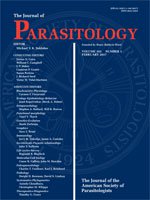Endogenous stages of the life cycle of Eimeria melanomytis, infecting the peripheral epithelial cells of villi of the small intestine of experimentally infected young dusky rice rats, Melanomys caliginosus, were studied. Giemsa-stained mucosal scrapings and histological sections were examined for all the stages. Eimeria melanomytis has 3 generations of meronts (M), different in size, shape, and number of merozoites (m); and in size, shape, and location of the nuclei within the cytoplasm of the meronts. The 3 meront types, M1–M3, respectively, had 11–14 (m1), 7–10 (m2), and 20–30 (m3) merozoites. Macrogametocytes and microgametocytes, as well as macrogametes and microgametes, complete the sexual cycle forming the unsporulated oocysts. This parasite's endogenous development produced severe intestinal lesions in experimentally infected dusky rice rats.
How to translate text using browser tools
1 February 2017
Endogenous Life Cycle of Eimeria melanomytis (Apicomplexa: Eimeriidae) from the Dusky Rice Rat, Melanomys caliginosus (Rodentia: Cricetidae: Sigmodontinae) in Costa Rica
Misael Chinchilla,
Idalia Valerio,
Ronald Sánchez,
Donald W. Duszynski
ACCESS THE FULL ARTICLE

Journal of Parasitology
Vol. 103 • No. 1
February 2017
Vol. 103 • No. 1
February 2017




